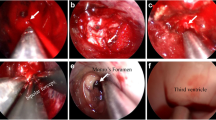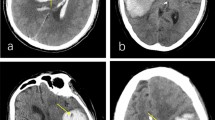Abstract
Introduction
Little information is available on the efficacy of aggressive treatment such as surgery in improving the outcome of severely affected patients after supratentorial intracerebral hemorrhage (ICH). Our objective was to assess the effect of hematoma removal and ventricular drainage on the mortality of patients with severe primary supratentorial ICH.
Methods
We studied 103 consecutive patients who were admitted to the intensive care unit and diagnosed with primary supratentorial ICH. The impacts of clinical factors on 30-day mortality were assessed, including surgery, Glasgow Coma Scale (GCS) score and pupillary abnormality at admission, hematoma volume, and other related factors.
Results
The 30-day mortality rate was 42%, and the median time between admission and death was 3 days (range: 1 to 27 days). Hematoma removal and ventricular drainage, within the first 24 hours of admission, were performed on 11 and 17 patients, respectively. Two patients who were treated with removal and four with drainage died. A logistic regression model for predicting 30-day mortality was performed. After controlling for GCS score, pupillary abnormality, hydrocephalus, and hematoma volume, hematoma removal was identified as an independent predictor of survival (odds ratio [OR], 0.12; 95% confidence interval [CI], 0.02 to 0.92). Ventricular drainage also tended to decrease mortality rate greatly (OR, 0.31; 95% CI, 0.06 to 1.76). Patients with GCS scores of 3 or 4 were 4.01 times more likely to die (95% CI, 1.13 to 14.26) than those with GCS of at least 5.
Conclusions
Hematoma removal may reduce the mortality rate of patients with severe supratentorial ICH.
Similar content being viewed by others
References
Broderick JP, Brott TG, Duldner JE, Tomsick T, Huster G. Volume of intracerebral hemorrhage: a powerful and easy-to-use predictor of 30-day mortality. Stroke 1993;24:987–993.
Nilsson OG, Lindgren A, Brandt L, Saveland H. Prediction of death in patients with primary intracerebral hemorrhage: a prospective study of a defined population. J Neurosurg 2002;97:531–536.
Giroud M, Gras P, Chadan N, et al. Cerebral haemorrhage in a French prospective population study. J Neurol Neurosurg Psychiatry 1991;54:595–598.
Collins TC, Petersen NJ, Menke TJ, Souchek J, Foster W, Ashton CM. Short-term, intermediate-term, and long-term mortality in patients hospitalized for stroke. J Clin Epidemiol 2003;56:81–87.
Dennis MS. Outcome after brain haemorrhage. Cerebrovasc Dis 2003;16(suppl 1):9–13.
Qureshi AI, Safdar K, Weil J, et al. Predictors of early deterioration and mortality in black Americans with spontaneous intracerebral hemorrhage. Stroke 1995;26:1764–1767.
Diringer MN, Edwards DF, Zazulia AR. Hydrocephalus: a previously unrecognized predictor of poor outcome from supratentorial intracerebral hemorrhage. Stroke 1998;29:1352–1357.
Lisk DR, Pasteur W, Rhoades H, Putnam RD, Grotta JC. Early presentation of hemispheric intracerebral hemorrhage: prediction of outcome and guidelines for treatment allocation. Neurology 1994;44:133–139.
Tuhrim S, Horowitz DR, Sacher M, Godbold JH. Validation and comparison of models predicting survival following intracerebral hemorrhage. Crit Care Med 1995;23:950–954.
Daverat P, Castel JP, Dartigues JF, Orgogozo JM. Death and functional outcome after spontaneous intracerebral hemorrhage: a prospective study of 166 cases using multivariate analysis. Stroke 1991;22:1–6.
Broderick JP, Adams HP Jr, Barsan W, et al. Guidelines for the management of spontaneous intracerebral hemorrhage: a statement for healthcare professionals from a special writing group of the Stroke Council, American Heart Association. Stroke 1999;30:905–915.
Fernandes HM, Gregson B, Siddique S, Mendelow AD. Surgery in intracerebral hemorrhage: the uncertainty continues. Stroke 2000;31:2511–2516.
Hankey GJ, Hon C. Surgery for primary intracerebral hemorrhage: is it safe and effective? A systematic review of case series and randomized trials. Stroke 1997;28:2126–2132.
Fujitsu K, Muramoto M, Ikeda Y, Inada Y, Kim I, Kuwabara T. Indications for surgical treatment of putaminal hemorrhage: comparative study based on serial CT and time-course analysis. J Neurosurg 1990;73:518–525.
Zuccarello M, Brott T, Derex L, et al. Early surgical treatment for supratentorial intracerebral hemorrhage: a randomized feasibility study. Stroke 1999;30:1833–1839.
Auer LM, Deinsberger W, Niederkorn K, et al. Endoscopic surgery versus medical treatment for spontaneous intracerebral hematoma: a randomized study. J Neurosurg 1989;70:530–535.
Juvela S, Heiskanen O, Poranen A, et al. The treatment of spontaneous intracerebral hemorrhage: A prospective randomized trial of surgical and conservative treatment. J Neurosurg 1989;70:755–758.
Batjer HH, Reisch JS, Allen BC, Plaizier LJ, Su CJ. Failure of surgery to improve outcome in hypertensive putaminal hemorrhage: a prospective randomized trial. Arch Neurol 1990;47:1103–1106.
Morgenstern LB, Frankowski RF, Shedden P, Pasteur W, Grotta JC. Surgical treatment for intracerebral hemorrhage (STICH): a single-center, randomized clinical trial. Neurology 1998;51:1359–1363.
Schwarz S, Jauss M, Krieger D, Dorfler A, Albert F, Hacke W. Haematoma evacuation does not improve outcome in spontaneous supratentorial intracerebral haemorrhage: a case-control study. Acta Neurochir (Wien) 1997;139:897–903.
Mendelow AD, Gregson BA, Fernandes HM, et al. Early surgery versus initial conservative treatment in patients with spontaneous supratentorial intracerebral haematomas in the International Surgical Trial in Intracerebral Haemorrhage (STICH): a randomised trial. Lancet 2005;365:387–397.
Becker KJ, Baxter AB, Cohen WA, et al. Withdrawal of support in intracerebral hemorrhage may lead to self-fulfilling prophecies. Neurology 2001;56:766–772.
Kwak R, Kadoya S, Suzuki T. Factors affecting the prognosis in thalamic hemorrhage. Stroke 1983;14:493–500.
Fujii Y, Tanaka R, Takeuchi S, Koike T, Minakawa T, Sasaki O. Hematoma enlargement in spontaneous intracerebral hemorrhage. J Neurosurg 1994;80:51–57.
Rabinstein AA, Atkinson JL, Wijdicks EF. Emergency craniotomy in patients worsening due to expanded cerebral hematoma: to what purpose? Neurology 2002;58:1367–1372.
Author information
Authors and Affiliations
Corresponding author
Rights and permissions
About this article
Cite this article
Ohwaki, K., Yano, E., Nagashima, H. et al. Surgery for patients with severe supratentorial intracerebral hemorrhage. Neurocrit Care 5, 15–20 (2006). https://doi.org/10.1385/NCC:5:1:15
Issue Date:
DOI: https://doi.org/10.1385/NCC:5:1:15




